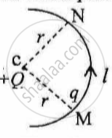Advertisements
Advertisements
प्रश्न
Does the charge given to a metallic sphere depend on whether it is hollow or solid? Give reason for your answer.
उत्तर
No, the charge given to a metallic sphere does not depend on whether it is hollow or solid because all the charge given to both the spheres will appear on the outer surface of the spheres.
APPEARS IN
संबंधित प्रश्न
Why can one ignore quantisation of electric charge when dealing with macroscopic i.e., large scale charges?
In Figure 1 below, a charge Q is fixed. Another charge q is moved along a circular arc MN of radius r around it, from the point M to the point N such that the length of the arc MN = l. The work done in this process is:

figure 1
Choose the correct option.
Two charges of 1.0 C each are placed one meter apart in free space. The force between them will be
Choose the correct option.
Two-point charges of A = +5.0 μC and B = -5.0 μC are separated by 5.0 cm. A point charge C = 1.0 μC is placed at 3.0 cm away from the centre on the perpendicular bisector of the line joining the two point charges. The charge at C will experience a force directed towards
Answer the following question.
State the law of conservation of charge.
+2 C and +6 C two charges are repelling each other with a force of 12 N. If each charge is given -2 C of charge, then the value of the force will be ______
Conservation of charges in tribo electric charging _________.
The dimensions of an atom are of the order of an Angstrom. Thus there must be large electric fields between the protons and electrons. Why, then is the electrostatic field inside a conductor zero?
A paisa coin is made up of Al-Mg alloy and weighs 0.75g. It has a square shape and its diagonal measures 17 mm. It is electrically neutral and contains equal amounts of positive and negative charges.
Treating the paisa coins made up of only Al, find the magnitude of equal number of positive and negative charges. What conclusion do you draw from this magnitude?
A steady current of 8 mA flows through a wire. The number of electrons passing through a cross-section of the wire in 10 s is ______.
